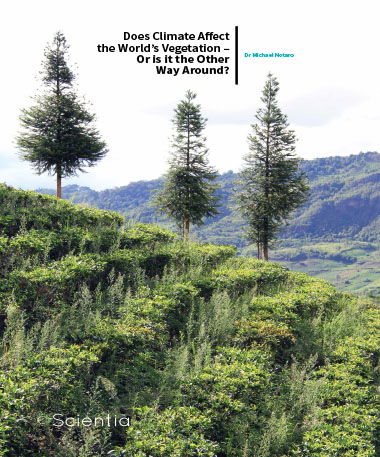Dr Michael Notaro – Does Climate Affect The World’s Vegetation – Or Is It The Other Way Around?
Climate scientist, Dr Michael Notaro, and his colleagues at the Nelson Institute Center for Climatic Research, University of Wisconsin–Madison, study climate variability and change, including how the weather, including monsoons, can be influenced by variations in vegetation in a given region of the world.
You’ve heard the slogan made popular by the World Wildlife Federation: ‘Plant a tree, save a planet.’ Or perhaps it’s the conservationists’ slogan, ‘Plant a tree, save a life’. Whatever the phrase, it’s clear that the benefits attributed to vegetation are multiple and well known. Trees absorb carbon dioxide and release oxygen; trees absorb groundwater and release moisture into the atmosphere; trees absorb impurities – or pollution – from the air; trees provide shelter for birds and other animals; trees provide raw materials for human civilisation. In short, trees are miraculous creations in nature that we should save, preserve and cherish for our benefit and the benefit of our planet.
However, some individuals and groups are concerned that climate change, or various extreme weather events that occur as natural variability in the Earth system, are causing adverse conditions that negatively affect the Earth’s vegetation. After all, the poor trees are sitting there innocently saving humanity while being set upon by storms, tornadoes, and tropical cyclones that damage them and cause disruption to their beneficial activities. But is this image correct? Are trees simply innocent ‘victims’ of climate change? Or do trees and other vegetation actually, in a sense, fight back? Scientists like Dr Michael Notaro are intensely interested in the latter picture – the power vegetation has to modify the climate around it, even to the point of affecting such massive meteorological phenomena as monsoons. Rather than passively allowing weather to push it around, our planet’s vegetation actually participates in the production of the climate that we experience.
Studying the Interaction Between Land and Climate
Vegetation generally can influence the climate in a number of ways. Vegetation can directly influence the climate through biophysical feedbacks via the momentum, energy, and moisture transfer that vegetation has with the atmosphere. Vegetation generally has greater roughness than the ground, thereby reducing wind speeds, increasing low-level atmospheric convergence of winds, supporting rising atmospheric motion, and therefore favoring more precipitation. Plants have a lower albedo (the amount of sunlight reflected by a surface) than dry desert soil or snow cover, so they can absorb more solar radiation, but the excess heat is at least partly offset by evaporative cooling from transpiration. Plants transpire soil moisture into the atmosphere, perhaps enhancing atmospheric moisture and rainfall. Plants basically control the ‘micro-climate’ around their leaves by absorption and release of heat and moisture. Furthermore, vegetation can indirectly affect the climate through biogeochemical processes that alter the atmospheric carbon dioxide concentration. Greater vegetation cover allows for more absorption of carbon dioxide, used for photosynthesis. This results in a lower concentration of carbon dioxide in the atmosphere, and thus, a reduction in the greenhouse effect. But until now, most studies on biophysical vegetation feedback have been restricted to running and analysing computer model simulations based on theoretical considerations. This doesn’t satisfy Dr Notaro, however.


‘In the real world, it is not feasible to perform large-scale vegetation
perturbation experiments to dynamically assess feedbacks to the
atmosphere, so a statistical method is necessary’
Since theoretical inputs that researchers feed into a climate model vary, climate computer models can differ dramatically in terms of simulated land-atmosphere interactions. In an article published a few years ago in the journal Climate Dynamics, Dr Notaro explained that many model experiments are based on radical baseline assumptions – such as total destruction of a massive forest, versus a more real-life scenario of patchy or partial deforestation. Very few studies have attempted to actually validate simulated vegetation feedback against actual vegetation and climate observations and give credibility to the model findings. For this reason and others, land-atmosphere interactions have been great sources of uncertainty in climate scenarios and simulations.
Generally speaking, the atmosphere’s effects on vegetation are stronger than vegetation’s effects on the atmosphere. This makes it quite challenging to extract the influence of vegetation fluctuations on atmospheric conditions using observational data. Furthermore, regional climate is affected by variability in both the ocean and vegetation, making it difficult to clearly separate their individual roles. ‘In the real world, it is not feasible to perform large-scale vegetation perturbation experiments to dynamically assess feedbacks to the atmosphere, so a statistical method is necessary,’ Dr Notaro tells Scientia. In other words, you can’t destroy a large forest – or magically produce one where it didn’t exist before – to obtain data to verify your computer model. But new techniques have arisen to help the situation.
Evaluating Models with Actual Physical Data
Climate scientists recently developed a multivariate statistical method, known as the Generalized Equilibrium Feedback Assessment (GEFA), and began using it for quantifying local and non-local feedbacks from a slowly-changing variable that can actually be measured in the climate system, such as sea-surface temperatures (SSTs) or leaf area index (LAI), to the atmosphere. Statistical estimates of oceanic and vegetation effects on the atmosphere across North America have already been validated dynamically with an ensemble of experiments in a fully coupled global climate model (GCM), that shows the reliability of this statistical approach. Since then, GEFA has been applied to observational and remotesensing data to separate the influences of individual oceanic and terrestrial effects on the atmosphere and to establish an observed benchmark against which models can be evaluated. Now models can be tested against measured variables to make sure the model is correctly designed and trustworthy for climate change projections. What Dr Notaro and his group were interested in, among other things, were monsoons.
In a report published in the Journal of Climate, Dr Notaro and his research group explored the way vegetation interacts with monsoons in different areas around the world, from China to Australia to the U.S. Southwest and Northern Mexico. They looked at vegetation’s effects on climate, on a sub-annual time scale, across six separate monsoon regions.

He and his colleagues used a fully coupled atmosphere–ocean–ice– land computer model that allows the atmosphere to interact with dynamic vegetation changes. They ran their initial calculations where the total vegetation cover fraction across the six global monsoon regions was reduced and the climatic response was assessed. Responses among the regions that were consistent included reductions in LAI, moisture and heat fluxes from the land to the atmosphere, and atmospheric moisture; enhanced atmospheric subsidence; and increases in ground and surface air temperature. The most distinct changes in vertical motion, precipitable water, and precipitation occurred along the edges of the monsoon season, with small changes in mid-monsoon rainfall. Unique responses to lower levels of vegetation cover were noted among the monsoon regions and some surprising results jumped out at the scientists. While the monsoon is delayed and weaker over northern Australia owing to diminished leaf area, it actually occurs earlier over China. The study suggested that the subtropical monsoon regions – cooler areas further from the equator – are characterised by a larger response in sensible heat than latent heat flux, while the opposite is true for tropical monsoon regions closer to the equator. Sensible heat describes the heat that’s absorbed or released by any substance while it changes temperature, while latent heat is the heat absorbed or released by a substance changing phase, e.g. solid to liquid or liquid to gas. Northern Australia experienced the most substantial decline in both moisture flux convergence – the concentration of moisture that precedes convection events like thunderstorms – and precipitation in response to reduced vegetation abundance.
What We Do to Our Vegetation Affects Our Climate
Dr Notaro concludes from this research that vegetation dynamics are most definitely important elements of the climate system, in particular over northern Australia. He agrees that climate models need to include better representations of observed vegetation and to be evaluated in terms of their simulated land-atmosphere interactions compared to observations. It is apparent that heat stress could reduce vegetation cover in certain regions, which could enhance surface warming. In the case of northern Australia, drought events can lead to loss of vegetation, which could amplify the drought intensity through positive vegetation–precipitation feedbacks. Ongoing farming practices in China and India and grazing in North America and northern Australia likely reduce the total leaf area and could lead to surface heating and a dampened water cycle. He and his colleagues are closing in on some of the specific answers to this phenomenon.
Dr Notaro investigated the hypothesis that subtropical and tropical monsoon regions showed unique responses to vegetation anomalies. He and his co-workers used a coarse global climate model, the Community Climate System Model (CCSM), and saw that reduced vegetation cover led to an earlier subtropical Chinese monsoon and delayed, weaker tropical Australian monsoon. However, significant climate and LAI biases in the coarse global climate model clouded the reliability of these findings. To fix this problem, the team used observed boundary conditions and applied them across China and Australia in the high-resolution Regional Climate Model Version Four (RegCM4). The model matched the observed dominance of crops, grass, and evergreen trees in southern China and grass and shrubs in northern Australia.

The team then ran a regional climate model for the period of 1960 to 2013. The Australian and Chinese monsoon regions’ LAI was modified in such a way as to look at contrasting vegetation effects between tropical and subtropical regions. He found that a greater leaf area supports reductions in albedo, air temperature, wind speed, atmospheric boundary layer height, and ascending motion and increases in diurnal temperature range, wind stress, evapotranspiration, and specific humidity. This leads to enhanced rainfall during Australia’s pre-mid monsoon season, but this was not found to be the case for China. Modified leaf area was found to cause dramatic changes in the temporal distribution and intensity of Australian rainfall events. Enhanced North Australian LAI supports a reduction in the frequency of dry periods, a greater frequency of drizzle or light-moderate rainfall periods, and decline in occurrence of extremely wet periods. In other words, the increase in LAI in northern Australia spreads the rainfall out over time so there are fewer dry spells and fewer heavy rain intervals. Inconsistencies between China’s monsoon response in RegCM4 and the one that Dr Notaro published a few years ago using CCSM are attributed to CCSM’s excessive forest cover and leaf area, exaggerated roughness mechanism, and deficient evaporation and transpiration response. Basically, that model ignored crops, so China was unrealistically represented as being covered with trees. Essentially though, the more forest you have, the greater effect you can have on even a significant climate phenomenon such as a monsoon. The implications are pretty impressive. Certainly, Dr Notaro aims to continue this line of investigation. But it’s more than just scientific curiosity that motivates him. Why is All of This Important? The timing and intensity of the summer monsoons has critical effects on, for example, the flooding in the Yangtze River Basin of China, drought in northern China and associated Yellow River flow and crop production both in China and Australia. It can also affect grazing stock and cattle productivity in Australia, along with the duration of fire-season across the Australian savannahs. A better understanding of the monsoon’s controls could help with seasonal predictions and agricultural planning. Moreover, validation of the computer model applied by Dr Notaro over the tropical Australian monsoon and subtropical Chinese monsoon will allow its successful application to other regions. This will potentially lead to the development of powerful climate prediction tools that can save lives and money. And perhaps we can try to plant appropriate trees and vegetation to actually help make a difference.
Why is All of This Important?
The timing and intensity of the summer monsoons has critical effects on, for example, the flooding in the Yangtze River Basin of China, drought in northern China and associated Yellow River flow and crop production both in China and Australia. It can also affect grazing stock and cattle productivity in Australia, along with the duration of fire-season across the Australian savannahs. A better understanding of the monsoon’s controls could help with seasonal predictions and agricultural planning. Moreover, validation of the computer model applied by Dr Notaro over the tropical Australian monsoon and subtropical Chinese monsoon will allow its successful application to other regions. This will potentially lead to the development of powerful climate prediction tools that can save lives and money. And perhaps we can try to plant appropriate trees and vegetation to actually help make a difference.
Meet the researcher

Dr Michael Notaro
Associate Director and Senior Scientist
Nelson Institute Center for Climatic Research
University of Wisconsin-Madison
Wisconsin, USA
Dr Michael Notaro received his PhD from the State University of New York at Albany in 2002, with a dissertation entitled ‘Model and observational analysis of the Northeast’s regional winter climate and its relationship to the PNA pattern’. He then joined the Center for Climatic Research at the University of Wisconsin–Madison as a Research Associate, where he is now a Senior Scientist and Associate Director of the Nelson Institute Center for Climatic Research. Dr Notaro’s research interests include the interactions between land, ocean and atmosphere; the impact of climate change on ecosystems; dynamical downscaling; the hydrology of the Great Lakes Basin; the study of lakeeffect snow; monsoon dynamics; and mechanisms of dust storms in the Middle East. He has authored and co-authored 65 articles published in peer-reviewed journals and has given 115 oral presentations in the field of atmospheric science.
CONTACT
T: (+1) 608 261 1503
E: mnotaro@wisc.edu
W: http://faculty.nelson.wisc.edu/notaro/index.html
KEY COLLABORATORS
Guangshan Chen, University of Wisconsin-Madison
Olga Kalashnikova, National Aeronautics and Space Administration, Jet Propulsion Laboratory
Zhengyu Liu, University of Wisconsin-Madison
Ahmed Tawfik, National Center for Atmospheric Research
Fuyao Wang, University of Wisconsin-Madison
Karl-Heinz Wyrwoll, University of Western Australia
Yan Yu, University of Wisconsin-Madison
FUNDING
Department of Energy
National Oceanic and Atmospheric Administration
National Science Foundation
REFERENCES
K-H Wyrwoll, FH McRobie, M Notaro and G Chen, Indigenous vegetation burning practices and their impact on the climate of the northern Australian monsoon region, Hydrol. Earth Syst. Sci. Discuss., 2013, 10, 10313–10332.
F Giorgi, E Coppola, F Solmon, L Mariotti, MB Sylla, X Bi, N Elguindi, GT Diro, V Nair, G Giuliani, UU Turuncoglu, S Cozzini, I Güttler, TA O’Brien, AB Tawfik, A Shalaby, AS Zakey, AL Steiner, F Stordal, LC Sloan, C Brankovic, RegCM4: model description and preliminary tests over multiple CORDEX domains, Climate Research, 2012, 52, 7–29.
M Notaro, K-H Wyrwoll and G Chen, Did aboriginal vegetation burning impact on the Australian summer monsoon?, Geophysical Research Letters, 2011, 38, L11704.
M Notaro, G Chen and Z Liu, Vegetation Feedbacks to Climate in the Global Monsoon Regions, Journal of Climate, 2011, 24, 5740.
Dr Michael Notaro Associate Director and Senior Scientist Nelson Institute Center for Climatic Research University of Wisconsin-Madison Wisconsin, USA


